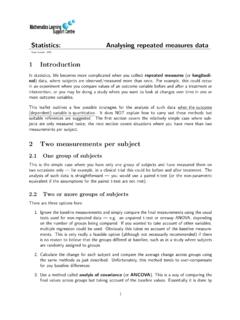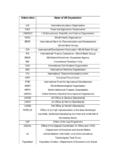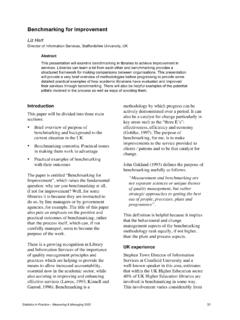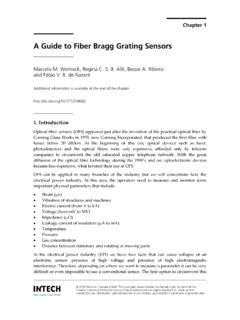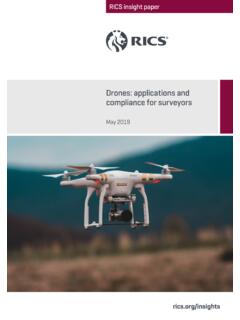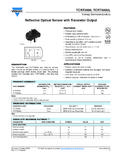Transcription of An Introduction to MEMS (Micro-electromechanical Systems)
1 Prime Faraday Technology Watch ISBN 1-84402-020-7 An Introduction to MEMS January 2002 An Introduction to MEMS (Micro-electromechanical Systems) MEMS has been identified as one of the most promising technologies for the 21st Century and has the potential to revolutionize both industrial and consumer products by combining silicon-based microelectronics with micromachining technology. Its techniques and microsystem-based devices have the potential to dramatically affect of all of our lives and the way we live. This report presents a general Introduction to the field of MEMS, with emphasis on its commercial applications and device fabrication methods. It also describes the range of MEMS sensors and actuators, the phenomena that can be sensed or acted upon with MEMS devices, and outlines the major challenges facing the industry.
2 PRIME Faraday Partnership PRIME Faraday Partnership This title is for sale in paperback at Technology Watch titles are written for managers, especially in small and medium-sized manufacturing companies. They offer a practical Introduction to cutting-edge developments that affect or likely soon will affect the design, development, manufacture and marketing of PRIME products products with interdependent mechanical and electronic (and possibly software) parts. All Technology Watch titles can be downloaded free of charge from the Prime Faraday Partnership s Technology Watch website Selected titles can be purchased in paperback from In addition to market and technology reviews, the Technology Watch website also provides news cuttings, case studies, an events diary and details of funding opportunities.
3 The service is sponsored by the DTI and managed by the PRIME Faraday Partnership, which marries the academic strengths of Loughborough University and the University of Nottingham to the technology-transfer expertise of Pera. An Introduction to MEMS Prime Faraday Technology Watch January 2002 Published in 2002 by PRIME Faraday Partnership Wolfson School of Mechanical and Manufacturing Engineering Loughborough University, Loughborough, Leics LE11 3TU 2002 Loughborough University ISBN 1-84402-020-7 Whilst the advice and information in this publication is believed to be true and accurate at the time of publication, neither the author nor the publisher assume any legal responsibility or liability for any error or omission that may have been made.
4 Comments on this publication are welcomed. Please send them to An Introduction to MEMS Prime Faraday Technology Watch January 2002 iii Contents Page 1. 1 2. Micro-electromechanical Systems (MEMS).. 1 What is MEMS?.. 1 Definitions and 3 4 6 Established MEMS 7 New MEMS MEMS Miniaturization 16 3. MEMS Fabrication 17 17 Materials for 18 Additive Films and Bulk Wet Dry 21 Surface 21 Fusion 23 23 Laser 24 Computer Aided Assembly and System 25 27 Multi-Chip Passivation and 29 Foundry 4.
5 MEMS 30 Mechanical Mechanical Mechanical 32 Radiation 34 Radiation 34 Radiation ( optical ) 34 Thermal Thermal Thermal Magnetic 36 Magnetic 36 Magnetic 37 Chemical and Biological 37 Chemical and Biological 37 Chemical Microfluidic 39 An Introduction to MEMS Prime Faraday Technology Watch January 2002 iv 5. Future of 41 Industry 41 The Way 43 44 Appendix A Glossary of 47 Appendix B Sources of MEMS Information and 49An Introduction to MEMS Prime Faraday Technology Watch January 2002 1 1. Introduction This report deals with the emerging field of micro-electromechanical systems, or MEMS.
6 MEMS is a process technology used to create tiny integrated devices or systems that combine mechanical and electrical components. They are fabricated using integrated circuit (IC) batch processing techniques and can range in size from a few micrometers to millimetres. These devices (or systems) have the ability to sense, control and actuate on the micro scale, and generate effects on the macro scale. The interdisciplinary nature of MEMS utilizes design, engineering and manufacturing expertise from a wide and diverse range of technical areas including integrated circuit fabrication technology, mechanical engineering, materials science, electrical engineering, chemistry and chemical engineering, as well as fluid engineering, optics, instrumentation and packaging.
7 The complexity of MEMS is also shown in the extensive range of markets and applications that incorporate MEMS devices. MEMS can be found in systems ranging across automotive, medical, electronic, communication and defence applications . Current MEMS devices include accelerometers for airbag sensors, inkjet printer heads, computer disk drive read/write heads, projection display chips, blood pressure sensors, optical switches, microvalves, biosensors and many other products that are all manufactured and shipped in high commercial volumes. MEMS has been identified as one of the most promising technologies for the 21st Century and has the potential to revolutionize both industrial and consumer products by combining silicon-based microelectronics with micromachining technology.
8 Its techniques and microsystem-based devices have the potential to dramatically affect of all of our lives and the way we live. If semiconductor microfabrication was seen to be the first micromanufacturing revolution, MEMS is the second revolution. This report introduces the field of MEMS and is divided into four main sections. In the first section, the reader is introduced to MEMS, its definitions, history, current and potential applications , as well as the state of the MEMS market and issues concerning miniaturization. The second section deals with the fundamental fabrication methods of MEMS including photolithography, bulk micromachining, surface micromachining and high-aspect-ratio micromachining; assembly, system integration and packaging of MEMS devices is also described here.
9 The third section reviews the range of MEMS sensors and actuators, the phenomena that can be sensed or acted upon with MEMS devices, and a brief description of the basic sensing and actuation mechanisms. The final section illustrates the challenges facing the MEMS industry for the commercialisation and success of MEMS. 2. Micro-electromechanical Systems (MEMS) What is MEMS? Micro-electromechanical systems (MEMS) is a process technology used to create tiny integrated devices or systems that combine mechanical and electrical components. They are fabricated using integrated circuit (IC) batch processing techniques and can range in size from a few micrometers to millimetres.
10 These devices (or systems) have the ability to sense, control and actuate on the micro scale, and generate effects on the macro scale. An Introduction to MEMS Prime Faraday Technology Watch January 2002 2 MEMS, an acronym that originated in the United States, is also referred to as Microsystems Technology (MST) in Europe and Micromachines in Japan. Regardless of terminology, the uniting factor of a MEMS device is in the way it is made. While the device electronics are fabricated using computer chip IC technology, the micromechanical components are fabricated by sophisticated manipulations of silicon and other substrates using micromachining processes.



